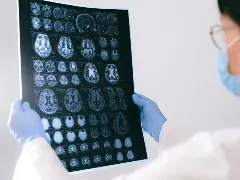

The nose, the unsung hero of breathing, plays a vital role in your overall well-being and deserves care as we age. In fact, the role of the nose goes far beyond simply detecting pleasant smells, which can conjure up powerful memories from the past. Doctors say it's important to understand how your nose works and how to keep it healthy and functioning properly because it serves as the body's frontline defense against airborne invaders. A nose in good health will seamlessly filter out debris from the air – trapping harmful particles before they can make their way into our lungs – while also moisturizing and humidifying the air you breathe. Is your nose up to snuff?
Aging Happens, Right Under Your Nose
It's not just our skin and joints that show the passage of time; the nose also undergoes changes which can impact its function. The nasal tip starts to droop due to a loss of structure and the skin inside your nose also becomes thinner due to a reduction in collagen and elastin.
Inside your nose, subtle transformations are also underway. These changes typically begin in your 40s, and they're not always immediately noticeable. The nasal valve and cartilage in your nose can weaken, and the side wall of the nose may start to collapse slightly when you take deep breaths. This isn't due to a sudden trauma, like an accident or rhinoplasty which can cause a more immediate weakening of the cartilage. It's a gradual change that can influence your ability to breathe comfortably.
Nasal Airway Obstruction: A Roadblock to Healthy Breathing
Unfortunately, for many people over 50, nasal issues can be more complex to treat and may require medical intervention. One of the most significant complaints is difficulty breathing through the nose. This can be a result of a common condition called nasal airway obstruction and it can be a major roadblock to a healthy lifestyle. Common symptoms of nasal airway obstruction include trouble sleeping, difficulty exercising, nasal congestion and frequent mouth breathing. Thankfully, there are strategies to address this concern, such as medications or sprays, which may decrease inflammation within the nasal cavity; however, they may provide only temporary relief.
When medications or sprays fall short, procedural treatments are considered like deviated septum surgery (septoplasty) and turbinate reduction, among other procedures. Minimally and non-invasive therapies are preferred whenever possible, especially for adults who have preexisting conditions and may not be good surgical candidates. Radiofrequency-based treatments, such as VivAer® (www.VivAer.com), effectively shrink the tissue in the nasal valve area (the smallest part of the nasal airway) to improve symptoms of nasal airway obstruction and can be performed in a doctor’s office under local anesthesia, with minimal downtime. This procedure is covered by Medicare and many other insurance plans when considered medically necessary, making it an appealing option.
Clearing up Rhinitis
If you’re always carrying tissues in your pockets to wipe your nose, you may have a condition called chronic rhinitis, or inflammation of the nasal mucosa linings. Symptoms include nasal congestion, runny nose, postnasal drip and sneezing, among others. As you age, your nose may become more inflamed and sensitive to environmental, seasonal, and/or physical irritants.
Consider the symptoms and causes associated with various types of chronic rhinitis:
- Allergic rhinitis, which is most commonly triggered by various allergens like pollen, mold, dust mites, and pet dander
- Non-allergic rhinitis, in which symptoms typically occur year-round and are not related to allergens but due to an overstimulation of blood vessels in the nose
If you’re suffering from a frequent runny, drippy nose, it might be time to seek the professional guidance of an otolaryngologist, or Ear, Nose & Throat physician, who can review treatment options that offer lasting relief. Treatment often begins with conventional options like medicated nasal or saline sprays, but for those experiencing persistent runny noses and postnasal drip that don't respond, there are advanced options like posterior nasal nerve (PNN) ablation, such as RhinAer (www.RhinAer.com). These office-based procedures involve techniques using radiofrequency (heat) or freezing (cryoablation) to ablate the posterior nasal nerve and reduce symptoms associated with chronic rhinitis, allowing for improved quality of life.
Understanding the changes your nose undergoes and being proactive about its health can make a significant difference in your overall well-being. As you navigate the golden years, remember that you have the power to take charge of your nasal health, ensuring you continue to breathe easy and fully embrace life's pleasures.
About the Authors
Dr. Roheen Raithatha graduated with a bachelor’s degree in biology from the University of Pennsylvania and received his Doctor of Medicine from Tufts University School of Medicine. Dr. Raithatha is board-certified from the American Board of Otolaryngology. He is currently on faculty at the Mount Sinai School of Medicine in New York City and is the chairman of the ENT & Allergy Advanced Sinus/Skull Base Center.
Dr. Raithatha is a fellowship-trained rhinologist who treats all Ear, Nose and Throat disorders in adults and children, with extra specialization in both medical and surgical treatments of sinus and nasal conditions, including nasal obstruction, snoring, epistaxis, acute and chronic sinusitis, nasal allergies, deviated nasal septum, enlarged turbinates, chronic rhinitis and sinonasal and skull base tumors.








Comments
Post a Comment